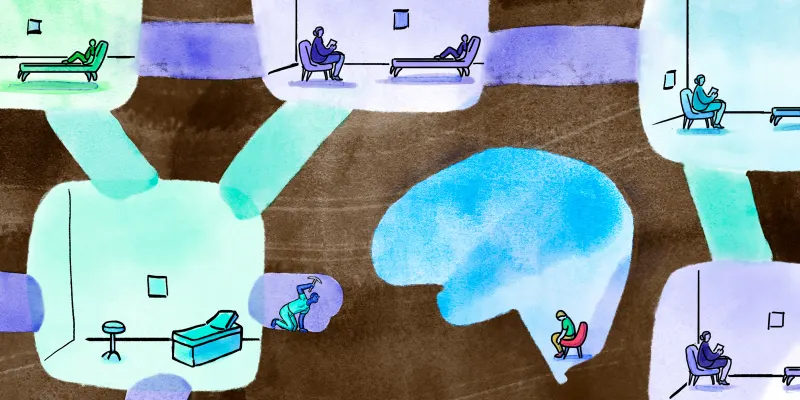
The hum of the machines was a constant reminder of the critical care setting waiting for us just outside of the consult room. We had sat down for a family meeting to discuss the prognosis for a newborn baby just one day old. The baby had holoprosencephaly and severe craniofacial defects and had been admitted to the neonatal intensive care unit for further management. A large stack of papers sat before us at the round table with notes from the outside hospital detailing the obstetric and birth history. The mother of the baby was not present because she was still recovering from a C-section at her birthing hospital. Mom had delivered five other children, all healthy and without complication. She was an older female around the age of 42. Her husband, and father to this new baby, was sitting with us in the conference room.
A bead of sweat had formed at the top of his forehead. I watched as he strummed his fingers nervously on his lap. The rhythm was mesmerizing and anxiety ridden. We were waiting for the Spanish interpreter only to find out that one wasn’t available now, given that it was approximately 4 a.m. and the emergency department had priority for this service. I was not able to locate a blue interpreter phone, so we pulled up the interpreter on a cellular device and passed it between us, literally a bridge between our two linguistic worlds.
Slowly, we reviewed the facts. I should mention the attendees included the fellow on call and myself, the overnight resident. Dad was the only family member present. I watched as his eyes glazed over, staring blankly while he shook his head as the fellow discussed the details.
“So, it seems as though you discussed the prognosis or the chance of your baby living at length with the neonatologists at the other hospital. It is documented here that you and your wife had decided on comfort care, but then after a conversation with a larger group of family members it was decided that you wanted to have everything done for the baby and that is why you were transferred to our facility. Is this correct?”
The interpreter requires repetition. I watch as the father nods his head in agreement. The blank look in his eyes nagged at my conscience.
The interpreter requires repetition. Parts of the conversation are lost because it is four in the morning, and the fellow is tired of repeating herself.
Finally, it is translated. Another blank stare and another nod of the head. The bead of sweat has fallen now and it is making its way down the front of his collared shirt. His eyes are becoming more bloodshot by the second.
“Okay, so we are going to do whatever is necessary to keep your daughter alive. She is having a hard time breathing, so we are going to connect her to a machine to help her breathe.”
A look of dismay. The one-sided conversation continues. The head nods just keep coming. Finally, at the end of the discussion, the father wants to ask a question.
“So, does this mean that my baby is going to die?”
I can feel the room shrinking. The walls are coming in closer and trying to suffocate me. I ponder if I just made up the entire last 30 minutes in my mind and if perhaps the conversation is just getting started. Could that be possible? I rub my eyes and take deep breaths trying to understand what exactly the father has understood. At this point, I’m not sure if he has absorbed any of the conversation at all.
No one in medical school teaches you how to have these conversations at four in the morning using an interpreter phone. No single person in residency does either. There is sometimes “role modeling” that takes place during these difficult moments in training, but not usually past 5 p.m. or so. No part of medical training prepares you for the heavy discussions that require attention and care on little to no sleep. Some practitioners may argue that this is a learned skill that cannot be taught and is simply polished by experience. Others may say that there should be more formal curriculum that focuses on this type of situation during medical training and beyond. I agree with the latter opinion.
“Well just as the other doctors explained to you already, there is a high chance that your baby might die because of her condition, but we are going to do everything possible to keep her alive.”
I think to myself, “because that is what you said you wanted.” And then I hear them, the doubts and the questions creeping in, finding a place between the constant beeps of the cardiac monitors in the background. Did he even know what he was saying when he said that? Does he truly understand the word prognosis? Does he have the knowledge and understanding to picture his daughter with a tracheostomy and some sort of feeding tube with likely little to no neurological function in the future if she is able to survive?
To this day, I am still unable to answer my own questions.
The baby was beautiful. Her head was perfectly round. Her fingers and toes totaled twenty and her belly was soft. Her coloring was pink. She did not have any designated space on her face for her eyes and she had one large orifice that served as both her nose and her mouth. She was heading toward intubation, given her degree of respiratory distress and which was only worsening with time. I wondered if this decision was the right one, considering her neurological status and her complex anatomy.
I try to imagine myself in the place of this father and his wife hearing through an interpreter the meaning of the situation and the appearance of the baby. I continue to arrive at the same conclusion; comfort care seems the most appropriate given that the baby would likely be neurologically devastated and that would ultimately lead to a very poor quality of life. I feel as though reaching this conclusion was much easier for me than for these parents, however. Furthermore, how could I ever really place myself in these parent’s shoes?
This is a debate that often arises during our ethical debriefing discussions. What if these parents want to care for a chronically ill child and do not feel that neurological devastation subtracts from the overall quality of life? What if their culture embraces this kind of illness? What if these parents would be extremely dedicated and take this baby to every doctor appointment every few months to assure the best care? Again, questions that remain unanswered.
What if there is a small chance that this baby will miraculously survive and suffer only small neurological deficits?
There it is, glistening in the corner of the father’s eye: hope. I can hear it bubbling underneath the surface of his “thank yous.” How can one deliver this heartbreaking news and the realities of the situation without extinguishing that small flame of hope? Hope is an interesting concept in medicine. It is like the huge purple elephant in the room that no one wants to address. And yet, I think that parents can maintain hope and still understand the truth of the poor outcomes surrounding their child’s health. Instilling false hope is a worse tragedy than allowing small hope to exist while acknowledging the severity of the situation.
A breathing tube is placed. The mother eventually arrives from the birthing hospital. Parents invite extended family. I observe the spectrum of emotion across their faces: fear, worry, hope, misunderstanding, confusion, and love. An echocardiogram reveals co-arctation of the aorta, and the baby is transferred to the CICU.
What happens from here? I have no idea. The neonatology fellow likely consults, but the cardiac team has become the primary team for the baby. A whole new set of caretakers with different or similar opinions from the original group are now in charge of the remainder of her care. Will the difficult conversations about prognosis and chances of survival and quality of life continue? Or will they be forgotten and blend into the background never to be directly addressed again?
Many questions unanswered. I lost track of the baby, but I have not forgotten about her. I often reflect on the presentation and the family. I think about the original decision to engage in comfort care only that was quickly replaced with a decision to do everything medically possible. I think back to the conversation at four in the morning with the interpreter phone and wonder how much of that moment the father even remembers.
I wonder if the baby underwent repair for her aortic co-arctation and, if she did, whether she survived. I know that I still do not know many of the answers to my questions and that they will likely remain unanswered.
But one thing is for certain: I will carry this moment with me forever, and I will apply learning points from this case to emotionally challenging situations throughout my future practice.
The door to the consult room was closed as I walked down the hallway to return to my computer. I sat down and began to concentrate on the other 35 babies on my census, the beeping of the monitors and the drips of the infusions keeping tempo in the background.







